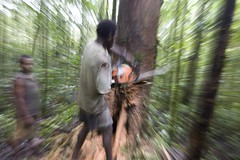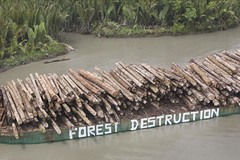 The poster child of human environmental destruction in the 90’s is still imperiled, even if the focus has shifted to global warming. Of course the two are intimately related, and besides the forests’ huge impacts on local watersheds—effectively creating their own rain—the forests’ trees and soils obviously have a major impact on the carbon cycle. Still, the onslaught upon the lungs of the world is not only unrelenting but expanding.
The poster child of human environmental destruction in the 90’s is still imperiled, even if the focus has shifted to global warming. Of course the two are intimately related, and besides the forests’ huge impacts on local watersheds—effectively creating their own rain—the forests’ trees and soils obviously have a major impact on the carbon cycle. Still, the onslaught upon the lungs of the world is not only unrelenting but expanding.
For instance, Brazil is currently pursuing a large hydroelectric project on the Xingu River. The Belo Monte will have 60% of the generating capacity of China’s controversial Three Gorges megadam project, making it the third largest in the world. Like Three Gorges, it will experience problems with siltation. The Amazon system is notoriously silty, and this is only exacerbated by ongoing deforestation. (Meanwhile dams are coming down in CA & OR for the salmon)
Additional pressures on the Brazilian Amazon stem from continued “land conversion” for ranching as well as soybean and sugar cane plantations. This expansion of agriculture is driven by demand for domestic biofuels, exports, and the low fertility of tropical soils.
 A third threat to the Amazon comes from expanding exploitation of natural gas and petroleum reserves in Peru (Full paper), and similar problems plague the Yasuni National Park in Ecuador. An attempt was made at Copenhagen to create a $3 billion trust for the protection of the most sensitive areas, but the agreement soon faltered leaving the future of “one of the world’s last high-biodiversity wilderness areas” future uncertain.
A third threat to the Amazon comes from expanding exploitation of natural gas and petroleum reserves in Peru (Full paper), and similar problems plague the Yasuni National Park in Ecuador. An attempt was made at Copenhagen to create a $3 billion trust for the protection of the most sensitive areas, but the agreement soon faltered leaving the future of “one of the world’s last high-biodiversity wilderness areas” future uncertain.
However all news of the Amazon is not so bleak.
Recently, Norway entered into an agreement with Guyana to avert deforestation.
 There are other rainforests besides the Amazon, and logging remains a major issue for those in Southeast Asia, from both illegal “harvesting” and legal exploitation and expansion of tree plantations for pulp and palm oil. Palm oil is prized by the processed food industry because of its long shelf life and semi-solid nature, and is also used by the cosmetics and cleanser industries to produce the foaming agent SLS. Unfortunately, oil palms are frequently placed in prime orangutan habitat which means these “men of the forest” have the dubious distinction of being among the half of all primates which face extinction.
There are other rainforests besides the Amazon, and logging remains a major issue for those in Southeast Asia, from both illegal “harvesting” and legal exploitation and expansion of tree plantations for pulp and palm oil. Palm oil is prized by the processed food industry because of its long shelf life and semi-solid nature, and is also used by the cosmetics and cleanser industries to produce the foaming agent SLS. Unfortunately, oil palms are frequently placed in prime orangutan habitat which means these “men of the forest” have the dubious distinction of being among the half of all primates which face extinction.
